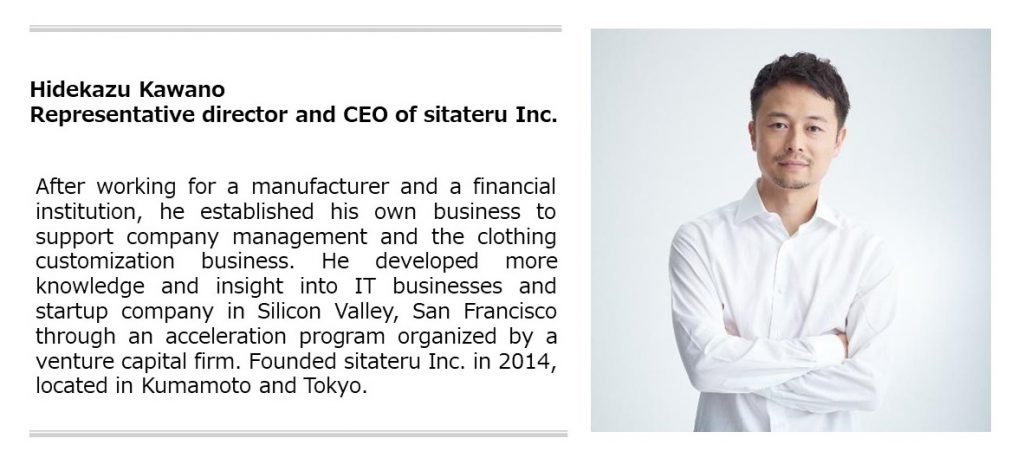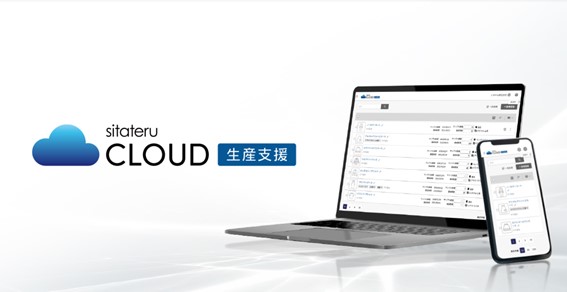sitateru Inc. is a Kumamoto-based startup company which has greatly changed the apparel industry since its establishment in 2014. The company provides a platform service “sitateru” to connect designers for all types of clothing and lifestyle goods with Japanese apparel manufacturing suppliers.
In 2019, Cool Japan Fund invested in the company with the aim of supporting Japanese apparel industry in streamlining and digitizing operations to create an environment where designers can more efficiently put their ideas into shape. Cool Japan Fund believes this will lead to increase in global competitiveness and overseas demand of the industry. (Click here to read the press release)
In April 2020, sitateru began providing a cloud-based system “sitateru CLOUD”, which is now receiving a lot of attention in the industry where the business situation is rapidly changing due to the pandemic.
We interviewed Hidekazu Kawano, the founder, representative director, and CEO of sitateru, to find out their future vision and goal as well as what they can do for the apparel industry. (The interview is as of June 2021)

Aiming for a Platform Where People with Ideas and People with Manufacturing Capabilities Actively Trade with Each Other
Q: How did users react to “sitateru CLOUD – Production support”?
We now have over 400 customers after launching the service a year ago. While our staff used to intervene in data and schedule management, liaising between apparel companies and factories, this new cloud service allows them to directly communicate with each other.
The apparel industry has become more interested in digitalization due to the pandemic. Using a cloud service enables them to significantly reduce costs while elevating productivity. Now, our service seems to be more valuable than ever. At the same time, I feel we have contributed to the factory side by creating transaction opportunities. For example, if the factories of major retailers cannot receive orders in flexible lots, there is a function that allows you to shift to the factories in sitateru’s network.
The more factories, the more users. The reverse is also true. We have almost established this cycle on the cloud. We currently provide two types: “Production support” and “Sales support”, and we plan to add more packages and functions, such as for D2C sales and for international transactions. The cloud infrastructure is just a means, but we aim to develop a platform where various companies can actively trade with each other.

Witnessing a Large Amount of Clothes to be Discarded Gave Me a Sense of Mission
Q: What is the backdrop behind the foundation of sitateru?
When I was supporting the management of companies in my hometown, Kumamoto, a specialty store in the city asked me for advice. To meet the segmented needs of customers, they wanted to purchase products in small quantities of dozens to hundreds from an apparel factory, but they could not do it. After research, I learned that there were many other businesses between the store and the factory, and the structure was quite complicated.
Therefore, I directly visited the factory and told them that a store in the neighboring town wanted a certain product in small quantities. They explained that factories have two seasons, slow and busy, and that they were able to handle small-lot production if the order was placed in slow seasons. So, I thought that I could efficiently match the two parties if I could provide accurate data about slow and busy periods of factories.
Another trigger was when I saw thousands of pieces of clothes with their price tags left in a large warehouse operated by a large-scale retailer. The plan was to burn or discard them in several days, although they totally looked wearable. It was unpleasant, seeing the business process and inventory management that did not permit resale. At the same time, a sense of mission motivated me to solve the issues.
Q: Then, you founded sitateru. What kind of challenges have you experienced when expanding the business?
When I launched the platform “sitateru” in 2015, over 100 users registered within a day or two. I thought that demand was high. We were also trying to find cooperating factories. They did not hesitate to work with us because many of them felt a sense of crisis as they faced the reduction of bulk orders from trading companies at that time. They were interested in doing something new with the internet.
Since the factories expected the stable orders from sitateru, we have always paid careful attention to see if we were able to meet their expectations or not. The weight should not be concentrated on one side, between demand or supply, so the most difficult thing was achieving an optimal balance between them while expanding business.
Q: Your head office is still located in Kumamoto. What is the reason for this?
When I stayed in San Francisco for a short time before, I found many platform businesses were able to make global deals without going through big cities. Similarly, our business model using the internet does not rely on a location or things. Although small in scale for now, we actually do business globally, and we will make the system multilingual in the future, adding languages such as English, Chinese, and Vietnamese. I have realized we are fully capable of doing business while the head office is situated in Kumamoto.
Kumamoto has abundant clean water. The quality is so high that the 4th Asia-Pacific Water Summit will be held here next year. However, I have heard recently that the natural spring water is being drained due to city development. My motivation to preserve this rich nature has been cultivated through living in Kumamoto and this has been also my driving force for the activities of sitateru.
<Related Article>
・Release People’s Imagination and Create a Prosperous Future―that is the Goal of sitateru (PartⅡ)













